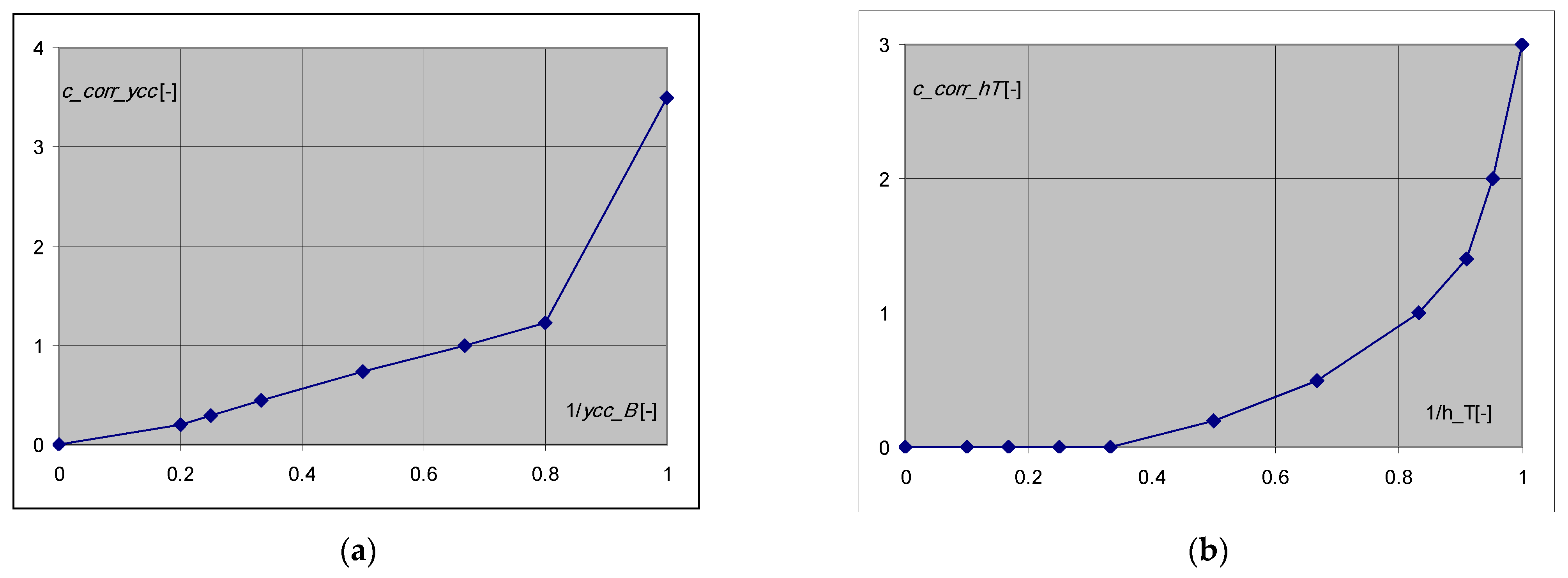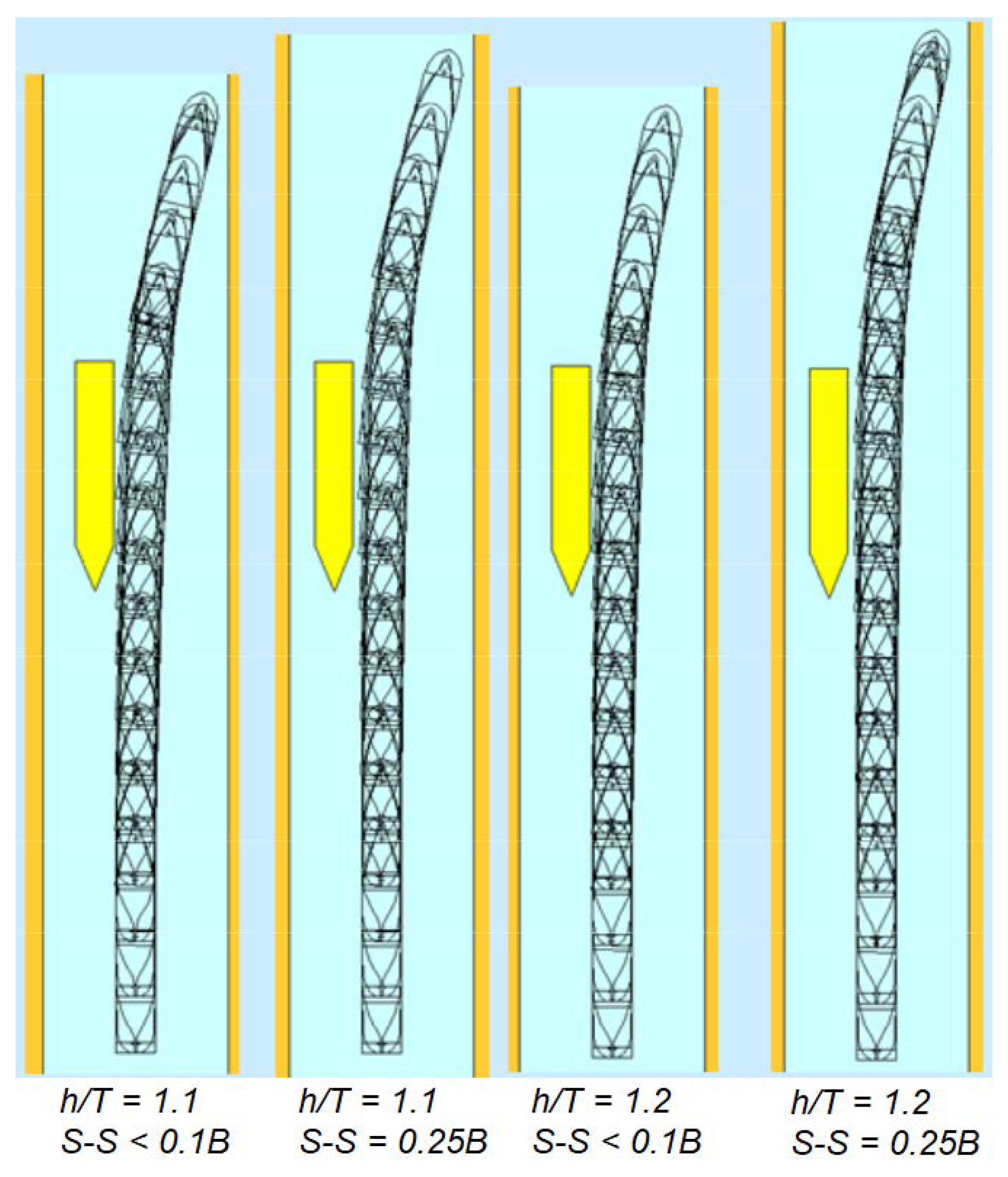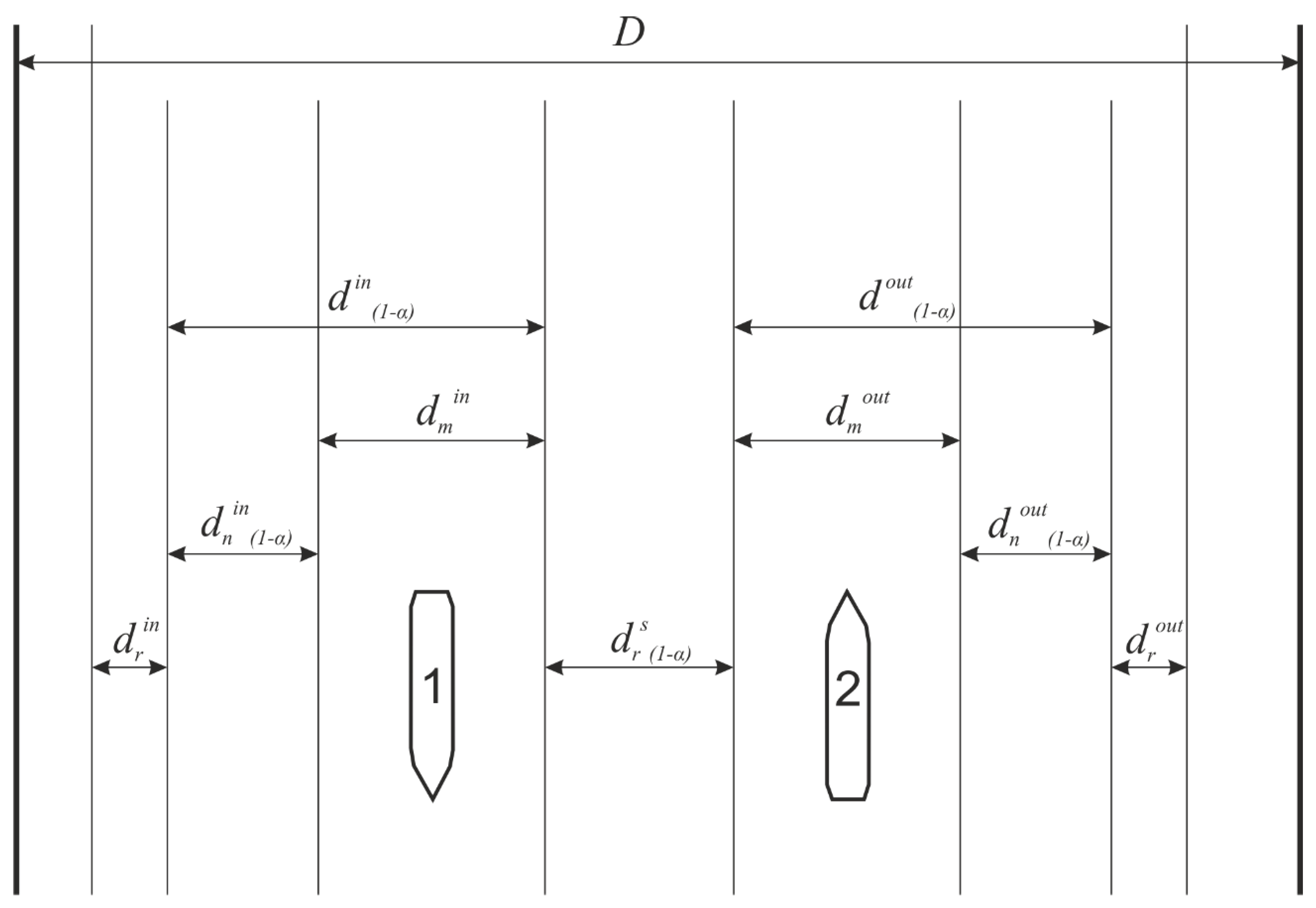Simulation Tests of the Passing Distance of Ships on a Two-Way Fairway
Abstract
:1. Introduction
- Parameters of passing ships;
- Reservoir parameters (e.g., depth, cross-section);
- Ship-to-ship interactions;
- Parameters (e.g., accuracy) of the navigation positioning systems on site;
- Individual navigator characteristics (e.g., qualifications).
- For speeds V ≤ 8 knots:
- For speeds V = 8–12 knots:
- For speeds V > 12 knots:
- The solution proposed by PIANC was adopted in the authors’ deterministic–probabilistic MTE (Marine Traffic Engineering) method [6], for which the differences relate to the methods of calculating the remaining components of the width of the safe maneuvering area.
- A further method used to determine the width of a two-way waterway is the method developed by the Japan Institute of Navigation [4]. In this solution, it is recommended to assume the value of the passing distance based on the type of the ship. The values range from 0.67B for fully loaded tankers to 1.95B for container ships.
- In view of the above, it can be concluded that the solutions proposed by the PIANC (and MTE) method as well as Spanish and Japanese methods do not take into account neither the results of contemporary model studies of ship-to-ship interactions regarding the particularly limited speeds at which the ships travel on fairways when passing, nor the accuracy of their positioning and the qualifications of navigators.
- The article attempts to determine, on the basis of the results of simulation studies, a safe and efficient distance between passing vessels considering the shortcomings of the above methods. The main assumptions of the proposed solution are:
- The simulation (mathematical) models of the movement of the studied ships consider the results of contemporary model studies on ship-to-ship interaction;
- The simulation experiment is carried out on a specific sections of the Świnoujście-Szczecin (Poland) waterway with existing visual navigation markings (aids-to-navigation) implemented on a FMBS-type simulator;
- The simulation experiment involves navigators experienced in maneuvering ships on investigated fairway (captains and pilots).
2. Materials and Methods
- Simulation studies of three passing, identically loaded ships (bulk carrier, tanker, and sea ferry) with lengths of 220 m, 103.6 m and 228 m, respectively, were carried out. The research was conducted on four sections of the Świnoujście-Szczecin waterway with different parameters and different navigational (optical) markings. The results of these studies were used to determine the distance between the passing ships on the fairway considering the accuracy of position determination.
- The distance between the passing vessels determined by a simulation method considers the accuracy of determining the position of passing vessels. This allows a modification of the deterministic–probabilistic MTE method that determines the width of the safe maneuvering area on the fairway for two-way traffic.
2.1. Ship-to-Ship Interaction in Model and Simulation Studies
- Passing, i.e., parallel movement on opposite courses (the subject of this article);
- Overtaking, i.e., similar movement, but on the equal courses and with different speeds;
- Passing a stopped or moored vessel—for methodological and application reasons, this case is treated independently, especially from the point of view of the danger to the moored vessel.
| ρ | – | water density |
| L | – | length (between perpendiculars) of the ship |
| T | – | draft of the ship |
| vo, vt | – | longitudinal velocity of the own and target ship |
| cfy_SS, cmz_SS | – | dimensionless coefficients of transverse force and moment, which are functions of six arguments:
|
- Side-to-side distance: <0.1B, 0.25B;
- vo, vt = 8, 10 kn and vo = 8, 10 kn and vt = 0 kn (stopped);
- h/T = 1.1, 1.2, 1.5.
2.2. Simulation Experiment of Passing Ships on Waterways
- Formulation of the research problem, including identification of the design goal, the simulation methods used and the type of simulators;
- Construction of ship movement models on a selected simulator and their verification, as well as construction of a basin model;
- Designing the experimental setup and conducting the experiment;
- Development and statistical analysis of research results.
- Kanał Piastowski (Piast Canal) (bottom width D = 110 m, depth h = 12.5 m)—passing ships LOA = 103.6 m;
- Zalew Szczeciński (Szczecin Lagoon) between the Brama Torowa (Fairway Gate) I and II (bottom width D = 100 m, depth h = 12.5 m)—passing ships LOA = 103.6 m;
- Zalew Szczeciński (Szczecin Lagoon) between the Brama Torowa (Fairway Gate) II and III (bottom width D = 250 m, depth h = 12.5 m)—passing ships LOA = 220 m;
- Świnoujście Port—Kanał Zbiorczy (Zbiorczy Canal) (bottom width D = 200 m, depth h = 8.0 m)—passing ships LOA = 228 m.
3. Results
- Kanał Piastowski: dmin1 = 26.4 m;
- Zalew Szczeciński between the Brama Torowa I and II: dmin2 = 20.8 m;
- Zalew Szczeciński between the Brama Torowa II and III: dmin3 = 37.9 m;
- Świnoujście Port—Kanał Zbiorczy: dmin4 = 41.9 m.
- Parameters of passing ships (i.e., their breadth);
- Parameters of the navigation systems used (accuracy of position determination).
4. Discussion
| D | – | width of the available maneuvering area |
| – | width of the safe maneuvering area of the ingoing ship at the specified confidence level (1-α) | |
| – | width of the safe maneuvering area of the outgoing ship at the specified confidence level (1-α) | |
| – | reserve of the width of the maneuvering area on the outer side of the ingoing ship | |
| – | reserve of the width of the maneuvering area on the outer side of the outgoing ship | |
| – | passing distance |
| – | maneuvering component of the width of the safe maneuvering area | |
| – | navigational component of the width of the safe maneuvering area determined at the confidence level (1-α) |
| – | directional error of the ship’s position perpendicular to the axis of the fairway determined at the confidence level (1-α) |
| – | transverse distance between beacons |
| – | distance between the banks of the channel |
- Kanał Piastowski: py(0.95) = 20 m;
- Zalew Szczeciński between Brama Torowa I and II Gate: py(0.95) = 15 m;
- Zalew Szczeciński between the Brama Torowa II and III: py(0.95) = 25 m;
- Port of Świnoujście (Kanał Zbiorczy): py(0.95) = 30 m.
5. Conclusions
- For the vessel breadth B ≥ 30 m
- For the vessel breadth B < 30 m
Author Contributions
Funding
Institutional Review Board Statement
Informed Consent Statement
Data Availability Statement
Conflicts of Interest
References
- Artyszuk, J.; Bilewski, M.; Gralak, R.; Gucma, L.; Gucma, M.; Gucma, S.; Marcjan, K.; Ślączka, W.; Zalewski, P. Marine Traffic Engineering. Guidelines for the Design of Marine Waterways and Ports and Conditions for Their Safe Operation; Foundation for the Promotion of the Shipbuilding Industry and the Maritime Economy: Gdansk, Poland, 2017. (In Polish) [Google Scholar]
- PIANC. Setting the Course, Harbour Approach Channels; Design Guidelines Report no 121–2014; PIANC: Brussel, Belgium, 2014. [Google Scholar]
- ROM 3.1-99; Design of the Maritime Configuration of Ports, Approach Channels and Harbour Basins; Spanish National Ports and Harbours Authority: Madrid, Spain, 2007.
- Ohtsu, K.; Yoshimura, Y.; Hirano, M.; Takahashi, H.; Tsugane, M. Design Standard for Fairway in Next Generation. Korean Inst. Navig. Port Res. 2006, 2, 230–239. [Google Scholar]
- PIANC Approach Channels. A Guide for Designs; PTC II-30 Final Report for the Joint Working Group, Supplement to Bulletin, No. 95; PIANC and IAPH in Cooperation with IMPA and IALA: Brussel, Belgium, 1997. [Google Scholar]
- Gucma, S. Marine Waterways. Design and Operation in Terms of Traffic Engineering; Foundation for the Promotion of the Shipbuilding Industry and the Maritime Economy: Gdansk, Poland, 2015. (In Polish) [Google Scholar]
- RINA. Proceedings of the 2nd International Conference on Ship Manoeuvring in Shallow and Confined Water (MASHCON): Ship to Ship Interaction, Trondheim, Norway, 18–20 May 2011; Pettersen, B., Berg, T.E., Eloot, K., Vantoree, M., Eds.; RINA: Trondheim, Norway, 2011; ISBN 978-1-905040-83-4. [Google Scholar]
- Vantorre, M.; Verzhbitskaya, E.; Laforce, F. Model Test-Based Formulations of Ship-Ship Interaction Forces. Ship Technol. Res. 2002, 49, 124–141. [Google Scholar]
- Gutenbaum, J. Mathematical Modeling of Systems; Polish Scientific Publishers (PWN): Warsaw, Poland, 2003. (In Polish) [Google Scholar]
- Gucma, S.; Gucma, L.; Zalewski, P. Simulation Research Methods in Marine Traffic Engineering; Maritime University of Szczecin Press: Szczecin, Poland, 2008. (In Polish) [Google Scholar]
- Dzwonkowski, J.; Gucma, M.; Gucma, S.; Kowalski, A. Pilot Navigation. Navigation in Restricted Waters; Maritime University of Szczecin Press: Szczecin, Poland, 2019. (In Polish) [Google Scholar]







| Fairway in Exposed Areas | Fairway in Sheltered Areas | |
|---|---|---|
| First factor: Vessel’s absolute speed | ||
| Greater than 6 m/s | 2.0B | - |
| Between 4 and 6 m/s | 1.6B | 1.4B |
| Less than 4 m/s | 1.2B | 1.0B |
| Second factor: Traffic density | ||
| 0–1 vessels/hour | 0.0B | 0.0B |
| 1–3 vessels/hour | 0.2B | 0.2B |
| >3 vessels/hour | 0.5B | 0.4B |
| Type | LOA (Length over All) [m] | LBP (Length between Perpendiculars) [m] | B (Breadth) [m] | T (Draft) [m] | CB (Block Coefficient) [–] | M (Main Engine Power) [kW] | |
|---|---|---|---|---|---|---|---|
| 1 | Tanker (chemical) | 103.6 | 97.4 | 16.6 | 7.1 | 0.76 | 3600 |
| 2 | Bulk carrier | 220.0 | 210.0 | 32.5 | 11.0 | 0.80 | 5500 |
| 3 | RoRo ferry | 228.0 | 211.0 | 32.0 | 6.3 | 0.67 | 18,000 |
| Fairway Section/ Ship Parameters | Passing Distance | ||
|---|---|---|---|
| Results of Simulation | Results According to a Proposed Relationship | ||
| 1 | Kanał Piastowski LOA = 103.6 m, B = 16.6 m | 26.4 m | |
| 2 | Zalew Szczeciński I-II BT LOA = 103.6 m, B = 16.6 m | 20.8 m | |
| 3 | Zalew Szczeciński II-III BT LOA = 220.0 m, B = 32.5 m | 37.9 m | |
| 4 | Port of Świnoujście LOA = 228.0 m, B = 32.0 m | 41.9 m | |
Disclaimer/Publisher’s Note: The statements, opinions and data contained in all publications are solely those of the individual author(s) and contributor(s) and not of MDPI and/or the editor(s). MDPI and/or the editor(s) disclaim responsibility for any injury to people or property resulting from any ideas, methods, instructions or products referred to in the content. |
© 2023 by the authors. Licensee MDPI, Basel, Switzerland. This article is an open access article distributed under the terms and conditions of the Creative Commons Attribution (CC BY) license (https://creativecommons.org/licenses/by/4.0/).
Share and Cite
Gucma, S.; Artyszuk, J.; Gralak, R.; Przywarty, M. Simulation Tests of the Passing Distance of Ships on a Two-Way Fairway. Appl. Sci. 2023, 13, 920. https://doi.org/10.3390/app13020920
Gucma S, Artyszuk J, Gralak R, Przywarty M. Simulation Tests of the Passing Distance of Ships on a Two-Way Fairway. Applied Sciences. 2023; 13(2):920. https://doi.org/10.3390/app13020920
Chicago/Turabian StyleGucma, Stanisław, Jarosław Artyszuk, Rafał Gralak, and Marcin Przywarty. 2023. "Simulation Tests of the Passing Distance of Ships on a Two-Way Fairway" Applied Sciences 13, no. 2: 920. https://doi.org/10.3390/app13020920






